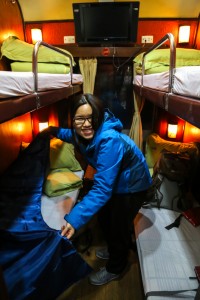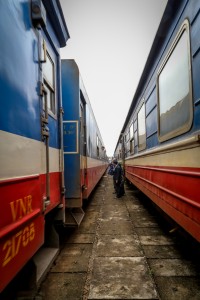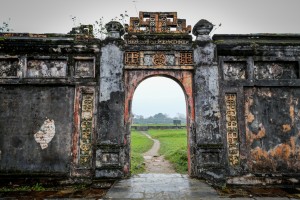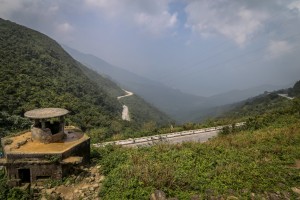After having a glimpse of vietnamese life in the north, our second stop was planned to be Vietnams‘ old imperial city Hue in the center of the country. Since Vietnam is a long S-shaped country along the coastline of the South China Sea, distances between north and south might be much bigger then one would expect at first and spread to over 2’200km in total. Common means of transport for this route include bus, train or plane. Since an 18hrs bus ride seemed to be rather tiring to us (though by far the cheapest option with tickets starts at arnd 20$) and flights (with a journey time of 1hr very fast) lack the possibility to gain some more insights of the country, we decided to take an overnight train. The journey took us about 15hours with the local night train line SE9 to cover the distance of abt 700km (average pace..eeem 45km/h?) and cost arnd 60$ per person. Prices heavily depend on the ticket class choosen (pre-booking is highly recommended since tickets sell out fast). Whereas locals tend to travel in cheap wooden hard seat classes where smoking, drinking and many other habits have to be expected, our class was the most expensive with a 4-berth soft sleeper shared cabin which offered great comfort to travel overnight.
starts at arnd 20$) and flights (with a journey time of 1hr very fast) lack the possibility to gain some more insights of the country, we decided to take an overnight train. The journey took us about 15hours with the local night train line SE9 to cover the distance of abt 700km (average pace..eeem 45km/h?) and cost arnd 60$ per person. Prices heavily depend on the ticket class choosen (pre-booking is highly recommended since tickets sell out fast). Whereas locals tend to travel in cheap wooden hard seat classes where smoking, drinking and many other habits have to be expected, our class was the most expensive with a 4-berth soft sleeper shared cabin which offered great comfort to travel overnight.
As we disembarked our train in Hue we had to wait in a corridor about 2m wide between our train and another one which was just about to depart. And so we got „in touch“ which one of the last secrets of the national vietnamese railway system: how they handle the discharge. Well then, hello to Hue. For the next two nights we were staying at a charming small guesthouse, priced at 20$ for a double a night incl. breakfast (if only our entire trip would be as cheap as here…)
Hue is a peaceful small town with an estimated population of about 300,000 (Hanoi has over 6mio.) and was the countrys‘ capital from 1802 to 1945. As we arrived the sky was still completely overcast with a light drizzle and more or less convenient temperatures arnd 20degrees. The first afternoon we spent browsing around the town and its largest market called Dong Ba trying some local food. Hue has many interresting and unique dishes to offer including Bun Bo Hue (Hue-style noodle soup with way more taste than Pho Bo from the north), banh beo (steamed rice pancakes), banh khoai (fried rice pancakes) or nem lui (lemongrass pork skewers) which are all very delicious and fresh.

 On our second day we spent almost the full day exploring the old imperial city built between 1802 and 1832 by thousands of workers for the emperor, his family and servants. The city initially consisted of more than 160 buildings double fortified by two walls and moats as long as 10km around the city. Though today only a dozen of these buildings are left due to heavy destruction during numerous wars, its still breathtaking to wander around in the ruins and see all its relicts. Most of the buildings, walls and stone bricks are earmarked by uncontrolled growth of small plants adding a mysterious and unique touch to the remnants of Hue’s past glory.
On our second day we spent almost the full day exploring the old imperial city built between 1802 and 1832 by thousands of workers for the emperor, his family and servants. The city initially consisted of more than 160 buildings double fortified by two walls and moats as long as 10km around the city. Though today only a dozen of these buildings are left due to heavy destruction during numerous wars, its still breathtaking to wander around in the ruins and see all its relicts. Most of the buildings, walls and stone bricks are earmarked by uncontrolled growth of small plants adding a mysterious and unique touch to the remnants of Hue’s past glory.
Though we wished to have more time for Hue, we sticked to our plan and went southwards to Hoi An. We booked a private tour from Hue to Hoi An for 69$ based on some reviews online. The tour took abt 6hours and we made a few stops on the way: a fishing village on a lagoon where people live and make their livings on boats, Lang Co Beach (not so exciting as now is not the right season for a swim), Hai Van Pass (Sea and cloud pass, had a coffee break and had a look at bunkers used by americans) and the Marble Mountain with caves. It was an informative tour as the drive r could speak some english so we could get some of our doubts answered such as how much it cost to build a house here etc. Just in case you are interested, in Hue you can build a house for $10k. If you have to buy land too, then make sure you have $20k ready. Though it may not sound a lot, but a family living on a boat would earn a mere usd1 per day. A local chef sells his noodle soup for as little as 50cents. 10k is certainly not little for an average vietnamese household.
r could speak some english so we could get some of our doubts answered such as how much it cost to build a house here etc. Just in case you are interested, in Hue you can build a house for $10k. If you have to buy land too, then make sure you have $20k ready. Though it may not sound a lot, but a family living on a boat would earn a mere usd1 per day. A local chef sells his noodle soup for as little as 50cents. 10k is certainly not little for an average vietnamese household.
We finally made it to Hoi An after a few stops and some hours, greeted by pots and pots of yellow Chrysanthemum blossoming for Tet, vietnamese new year. We will have a homestay called Flower Garden for the next three days; again, at a rate of less than 30$ per room incl breakfast.
